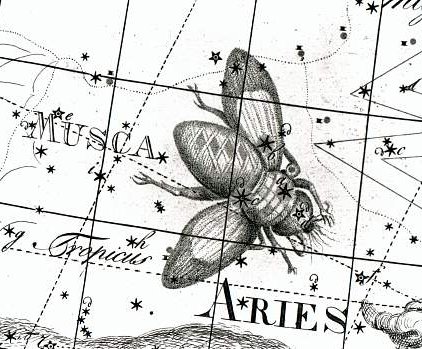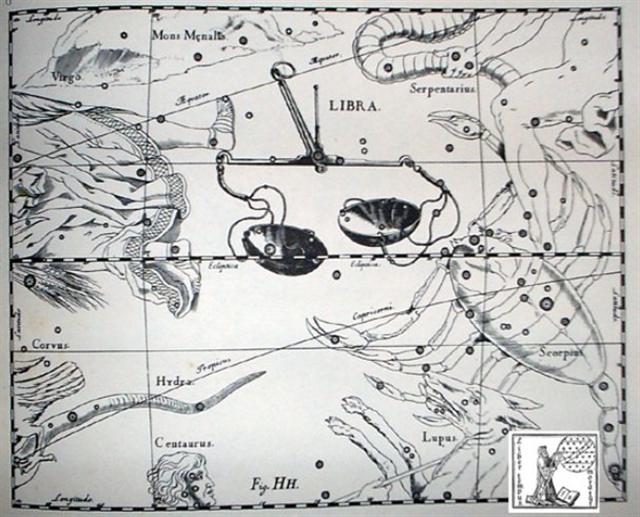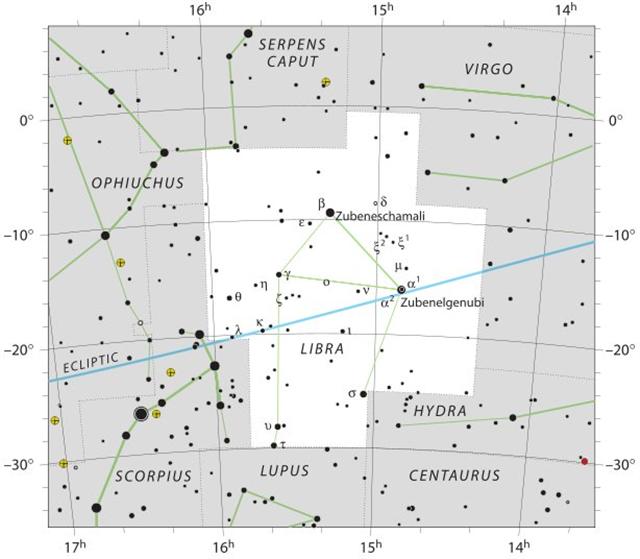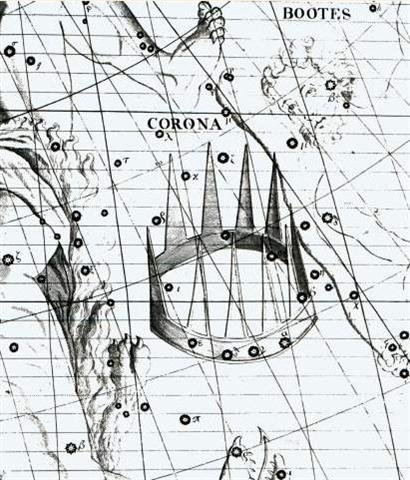From the Southern Claw up to and including the Northern Claw, of
the ancient Scorpion, there was a week:

| te maitaki |
kua hua te kahi |
te ahine poo puo |
ki te huaga |
ki te huaga |
te kahi |
|
Hua. 1. Testicle. 2.
Figuratively: son, hua tahi, only son; fruits
of the earth; to grow well (of fruits). 3. To cause
a fight, a quarrel. Hua-ai, generation, as
lineage of direct descendents;
contemporaries. Huahua, coccyx of bird,
'parson's nose': huahua moa, huahua uha.
Huataru, a creeper (Chenopodium
ambiguum). Vanaga. 1. The same; ki hua,
again, to continue, to strain, to struggle, to move,
to repeat, over and above. Mq.: hua, the
same, to return, to recommence. 2. To bloom, to
sprout; flower, fruit (huaa); huaa
tae oko, huaa vahio, young fruit; hua atahi,
only son; huahaga, fruit; mei te huahaga o
tokoe kopu, the fruit of thy body; tikea
huahaga, deceptive appearance. P Pau.: ua,
to be born; huahaga, lineage. Mgv.: hua,
to produce (said of trees, grain, etc.), blooming
time of flowers, abundance of fruit. Mq.: hua,
to produce, to bear fruit. Ta.: ua, to
sprout. Huahua. 1. Tailless fowl. 2. Vein,
tendon, line. 3. Mgv.: huahua, pimples
covering the face. Ta.: huahua, id. Mq.:
hua, tubercules. Sa.: fuafua, abscess on
hand or feet. Ma.: huahua, small pimples.
Pau.: Hua-gakau, rupture. Ta.: áau,
entrails. Sa.: ga'au, id. Ma.: ngakau,
id. Churchill. 1. Fruit. 2. Egg. 3. Tā
hua = 'genealogical writing' or 'same writing'.
Fischer.
Kahi. Tuna; two sorts:
kahi aveave, kahi matamata. Vanaga. Mgv.:
kahi, to run, to flow. Mq.: kahi, id.
Churchill. Rangitokona, prop up the heaven!
// Rangitokona, prop up the morning! // The
pillar stands in the empty space. The thought [memea]
stands in the earth-world - // Thought stands also
in the sky. The kahi stands in the
earth-world - // Kahi stands also in the sky.
The pillar stands, the pillar - // It ever stands,
the pillar of the sky. (Morriori creation myth
according to Legends of the South Seas.) |
 |
 |
 |
 |
 |
 |
|
Cb8-24 |
Cb8-25 |
Cb8-26 |
Cb8-27 |
Cb8-28
(199) |
Cb8-29
(584 + 8) |
|
CLOSE TO THE FULL
MOON: |
|
Oct 28 →
Cb8-28 |
29 |
30 |
31 |
Nov 1
(305) |
2 |
|
ρ
Lupi (221.0),
TOLIMAN
(Shoot of the Grapevine) =
α
Centauri
(221.2),
π
Bootis (221.8),
ζ
Bootis (221.9) |
31 Bootis (222.0),
YANG MUN (South Gate) =
α
Lupi
(222.1),
RIJL AL AWWA (Foot of the Barker) =
μ
Virginis
(222.5),
ο
Bootis (222.9) |
IZAR (Girdle) =
ε
Bootis
(223.0),
109 Virginis,
α
Apodis (No Feet)
(223.3),
μ
Librae (223.8) |
Al Zubānā-14a
(Claws) /
Visakha-16 (Forked) /
Root-3 (Badger)
ZUBEN ELGENUBI
(Southern Claw)
=
α
Librae
(224.2),
ξ
Bootis,
ο
Lupi (224.5) |
KOCHAB
(Kakkab,
the Star) = β Ursae Min.
(225.0), ξ Librae (225.7) |
KE KWAN (Cavalry Officer) =
β
Lupi
(226.3),
KE KWAN =
κ
Centauri (226.4),
ZUBEN ELAKRIBI (Claw of the Scorpion) =
δ
Librae
(226.8),
π¹
Oct.
(226.9)
*185.0 = *226.4 - 41.4 |
|
'Oct 1 |
2 |
3 |
4 (277) |
5 |
6 |
|
"Sept 17
(364 - 104) |
18 (9 * 29 = 261) |
19 |
HORA NUI 20 |
21 (364
- 100) |
Equinox |
 |
|
CLOSE TO THE
SUN: |
|
ν Arietis (38.5), δ, ε Ceti (38.8) |
μ
Arietis (39.4),
HEAD OF THE FLY = 35 Arietis
(39.6),
KAFFALJIDHMA (Part of a Hand) =
γ
Ceti,
θ
Persei (39.8) |
π
Ceti,
ο
Arietis (40.0),
ANGETENAR (Bend in the River) =
τ¹
Eridani,
μ
Ceti (40.2),
RIGHT WING = 39 Arietis
(40.9) |
Bharani-2 (Yoni) /
Stomach-17 (Pheasant)
π
Arietis (41.2),
MIRAM (Next to the Pleiades) =
η
Persei
(41.3),
BHARANI
= 41 Arietis (41.4),
τ²
Eridani,
σ
Arietis (41.7) |
TA LING (Great Mound) = τ Persei
(42.4)
*1.0 = *42.4 - *41.4 |
ρ
Arietis (43.0),
GORGONEA SECUNDA =
π
Persei
(43.5),
ACAMAR (End of the River) =
θ
Eridani
(43.6),
ε
Arietis (43.7),
λ
Ceti (43.9)
DENEBOLA (β Leonis) |
 |
And in the middle of this week was the π day with σ Librae
close to the Full Moon:
| Vai o ero
hia |
kua tere |
ki te marama |
kua oho |
|
Hiero. To shine, to
appear (of the rays of the sun just before
sunrise). He hiero te raá, dawn breaks.
Vanaga.
|
ka ero |
|
 |
|
Aa1-16 |
|
 |
 |
 |
 |
|
Cb9-1 (593 → 59 * 3 = 177) |
Cb9-2 |
Cb9-3 |
Cb9-4 (204) |
|
CLOSE TO THE
FULL MOON: |
|
Nov
3 (*227 → 22 / 7 = π) |
4 |
5 |
6
(310) |
|
ω Bootis (227.2),
NEKKAR (Herdsman) = β Bootis
(227.3),
σ Librae
(227.5), π² Oct. (227.7),
NADLAT (Mean Little Ones) = ψ Bootis
(227.8), π Lupi (227.9)
224.2 + 3.3 = 230.8 - 3.3 |
15h (228.3)
ZUBEN HAKRABIM = ν Librae
(228.3), λ Lupi (228.9) |
ω
Oct. (229.3),
ι
Librae (229.6),
κ
Lupi (229.7),
ζ
Lupi (229.8) |
Al Zubānā-14b (Claws)
χ
Bootis (230.3),
PRINCEPS =
δ
Bootis
(230.6),
ZUBEN ELSCHEMALI
(Northern Claw) =
β
Librae
(230.8) |

 |
|
'Oct
7 (280) |
8 |
9 |
10 |
|
RUHI HEPII ? |
24 |
25 |
HORA NUI 26 |
|
he oho mai te Honu a Ira.a te
rara matau.he hira mai te mata a uta he ui mai
ruhi hepii he rapa
atu te rei.mai ruhi hePii
... Late in the afternoon or
toward evening, when the sun is in the west, the
rays strike the ornaments and the reflected
light can be seen by canoes approaching the
shore. To this day, the Easter Islanders have a
well-developed system of fixed points along the
shore that helps fishing boats determine their
positions. Perhaps the 'beacons' of Ruhi
Hepii and Pu were intended to focus
on a point out at sea to the west of Apina,
since this is the best landing site for
(European) ships. However, this explanation is
unsatisfactory primarily because the shining
ornaments were intended as guides to voyagers
from Polynesia. I would rather suspect that
Ruhi Hepii and Pu were designations
for two stars, which were essential in
determining the proper sea route from the land
of origin to Easter Island. The information,
which was projected westward by the two
'beacons', only had to be applied to the proper
season, and, with the help of the (heliacal)
pattern of the rising stars, the route across
the sea became fixed in the memory of the
immigrants. Since 'adornment' (rei) is
sometimes part of the name of a star (RAP.
tuhi rei and rei atanga, Barthel 1962b:3),
it could be considered a likely astronomic indicator
... |
|
CLOSE TO THE
SUN: |
|
May 4 (124) |
5 (5 * 5 * 5) |
6 |
7 |
|
MENKAR
(The Nose) = α Ceti
(44.7) |
3h (45.7)
GORGONEA TERTIA =
ρ
Persei
(45.1),
ALGOL
(The Demon) = β Persei
(45.9) |
ι
Persei (46.1),
MISAM (Next to the Pleiades) =
κ
Persei
(46.2),
GORGONEA QUARTA =
ω
Persei
(46.7),
BOTEIN (Pair of Bellies) =
δ
Arietis
(46.9) |
ζ Arietis (47.7) |
|
°April 30 (120) |
°May
1 (*41) |
2 |
3 |
|
'April 7 |
8 |
9 |
10
(100) |
|
"March 24 (83) |
Julian equinox |
26 |
27 |
|
MARCH 1 |
2 |
3 |
4 (63 = 47 + 16) |
|
DAY
44 |
45 |
46 |
47 |
 |
Counting from Spica at the Full Moon up to and
including Zuben Hakrabim the measure was 85 - 58
("February 27 → π) = 27 days.
| te hokohuki |
te moko |
vero
hia |
tagata honui |
e
ha mata |
|
Ha. 1. Four. 2. To
breathe. Hakaha'a, to
flay, to skin. Vanaga. 1. Four. P Mgv., Mq., Ta.: ha, id.
2. To yawn, to gape. 3. To heat. 4. Hakaha,
to skin, to flay; unahi hakaha, to scale
fish. Mgv.: akaha, to take to pieces, to
take off the bark or skin, to strip the leaves
off sugarcane. 5. Mgv: ha, sacred,
prohibited. Mq.: a, a sacred spot. Sa.:
sa, id. Churchill. |
 |
 |
 |
 |
 |
|
Cb8-4 |
Cb8-5 (172 + 4) |
Cb8-6 (177 = 6 * 29½) |
Cb8-7 (392 + 178 = 570) |
Cb8-8 (1½ * 314 + 100) |
|
CLOSE TO THE
FULL MOON: |
|
γ Hydrae (201.0), ι Centauri (201.4) |
Al Simāk-12 (Lofty) /
Chitra-14 (Bright One) /
Horn-1 (Crocodile) /
Sa-Sha-Shirū-20
(Virgin's Girdle) /
ANA-ROTO-3 (Middle pillar)
MIZAR = ζ Ursae Majoris
(202.4),
SPICA
= α Virginis,
ALCOR
= 80 Ursae Majoris
(202.7)
SADALMELIK (α Aquarii)
*161.0 = *202.4 - *41.4 |
71 VIRGINIS
(203.6) |
no
star listed (204) |
HEZE = ζ Virginis
(205.0),
Southern Pinwheel Galaxy = M83 Hydrae
(205.7) |
|
... Proclus
informs us that the fox star nibbles
continuously at the thong of the yoke which
holds together heaven and earth; German folklore
adds that when the fox succeeds, the world will
come to its end. This fox star is no other than
Alcor, the small star g near zeta Ursae
Majoris (in India Arundati, the common
wife of the Seven Rishis, alpha-eta Ursae
...
 |
|
... Mons
Maenalus, at the feet of Boötes, was formed
by Hevelius, and published in his Firmamentum
Sobiescianum; this title coinciding with
those of neighboring stellar groups bearing
Arcadian names. It is sometimes, although
incorrectly, given as Mons Menelaus, -
perhaps, as Smyth suggested, after the
Alexandrian astronomer referred to by Ptolemy
and Plutarch. The Germans know it as the Berg
Menalus; and the Italians as Menalo.
Landseer has a striking representation of the
Husbandsman, as he styles Boötes, with sickle
and staff, standing on this constellation
figure. A possible explanation of its
origin may be found in what
Hewitt writes in his Essays on the Ruling
Races of Prehistoric Times: The Sun-god
thence climbed up the mother-mountain of the
Kushika race as the constellation Hercules, who
is depicted in the old traditional pictorial
astronomy as climbing painfully up the hill to
reach the constellation of the Tortoise, now
called Lyra, and thus attain the polar star
Vega, which was the polar star from 10000 to
8000 B.C.
May not this modern companion constellation,
Mons Maenalus, be from a recollection of this
early Hindu conception of our Hercules
transferred to the adjacent Bootes?
 |
|
Oct
8 (240 + 41) |
9 |
10 |
11 (364 - 80) |
12 (285) |
|
'Sept 11 (354 - 100) |
12 |
13
(256 = 4 * 64) |
14 |
15 |
|
"Aug
28 (240) |
HORA ITI 29 |
30
(242 = 2 * 11 * 11) |
31 |
HORA NUI 1 |
|
AHU
AKAPU |
PU
PAKAKINA A IRA |
|
Paka. 1. Dry; to become dry (of
things); pakapaka, to dry out. Te paka
is also the name of the moss-covered areas,
between the small lakes of volcano Rano Kau,
through which one can pass without getting
one's feet wet. 2. To go, to depart;
he-paka-mai, to come; he-oho, he-paka,
they go away. 3. To become calm (of the
sea): ku-paka-á te tai. Pakahera,
skull, shell, cranium; pakahera puoko tagata,
human skull; pakahera pikea, shell of
crab or crayfish. Gutu pakapaka, scabbed
lips. Hau paka, fibres of the hauhau
tree, which were first soaked in water, then
dried to produce a strong thread. Moa gao
verapaka, chicken with bald neck. Ariki
Paka, certain collateral descendents of
Hotu Matu'a, who exercised religious
functions. Vanaga. 1. Crust, scab, scurf;
paka rerere, cancer; pakapaka, crust,
scabby. 2. Calm, still. 3. Intensive; vera
paka, scorching hot; marego paka,
bald; nunu paka, thin. 4. To arrive, to
come. 5. To be eager. 6. To absorb. 7. Shin T.
Pakahera, calabash, shell, jug.
Pakahia, to clot, curdle, coagulate.
Pakapaka, dry, arid, scorching hot, cooked
too much, a desert, to fade away, to roast, a
cake, active; toto pakapaka, coagulated
blood; hakapakapaka, to dry, to broil, to
toast. Pakahera pikea, shell of crab or
crayfish. Churchill.
Kinana,
s. Haw., a hen that has hatched chickens.
Sam., tina,
a mother.
Tong., tina-manu, a sow that had litter.
Tah., ti'a,
the lower part of the stomach, below the navel.
Fiji., tina,
mother; tina-tina, mother of inferior
animals. N.
Zeal., tinana, the buttocks, trunk, body.
This word, with
somewhat varying but not far separate meanings,
I am inclined to consider as related to the
Goth., kwens,
kwino, a woman; kwina-kunds and
kwineins, female; and possibly kwithus,
the womb, the stomach, if that is syncope of an
original kwinthus. Greek,
γυνη, woman
... |
|
CLOSE TO THE
SUN: |
|
April 8 |
9 |
10
(100) |
11 |
12 |
|
no
star listed (18) |
ADHIL
(Garment's Train) = ξ Andromedae
(19.3),
θ
Ceti (19.7) |
KSORA (Knee) = δ Cassiopeiae
(20.1),
ω
Andromedae (20.6),
γ
Phoenicis (20.8) |
δ
Phoenicis (21.5) |
υ Andromedae (22.9) |
|
'March 12 |
13 |
14
(73) |
15 |
16 |
|
"Febr 26 |
TE-HETUU-PU
27 |
28
(59) |
29 |
"March 1 |
 |
The Explorers were at Pu Pakakina 'for a month'
(E:31) -
he noho
etahi marama.i pu pakakina.
|
CLOSE TO THE
FULL MOON: |
|
Spica (*161) |
21 |
α Librae (*183) |
5 |
β Librae (*189) |
|
HORA ITI 29 (241) |
HORA NUI 20 (263) |
HORA NUI 26 (269) |
|
29 |
|
PU PAKAKINA A IRA |
|
CLOSE TO THE
SUN: |
|
"Febr 27 (58 = 241 - 183) |
21 |
"March 21 (80) |
5 |
"March 27 (86) |
|
ξ Andromedae (*344) |
Bharani
(*183 + *183) |
ζ Arietis (*6) |
In the A text number 29 was used when counting from
one viri to the next and 29 signified the
dark night of Ohiro (Mercury).
... Ganz ähnlich is der Name 'Gott von Duazag'
des Gottes Nabū ... zu erklären.
Er bezeichnet ihn als den Gott des Wachtstums,
welches als aus dem Osten stammend betrachtet wird,
weil die Sonne, die das Wachstum bringt, im Osten
aufgeht.
Dass aber Nabū als Ost-Gott aufgefasst wurde,
hängt damit zusammen, dass sein Stern, der Mercur,
nur im Osten oder Westen sichtbar ist ...

|
Hiro.
1. A deity invoked when
praying for rain (meaning uncertain). 2.
To twine tree fibres (hauhau, mahute)
into strings or ropes. Ohirohiro,
waterspout (more exactly pú ohirohiro),
a column of water which rises spinning
on itself. Vanaga. To spin, to twist. P
Mgv.: hiro, iro, to make a
cord or line in the native manner by
twisting on the thigh. Mq.: fió,
hió, to spin, to twist, to twine.
Ta.: hiro, to twist. This differs
essentially from the in-and-out movement
involved in hiri 2, for here the
movement is that of rolling on the axis
of length, the result is that of
spinning. Starting with the coir fiber,
the first operation is to roll (hiro)
by the palm of the hand upon the thigh,
which lies coveniently exposed in the
crosslegged sedentary posture, two or
three threads into a cord; next to plait
(hiri) three or other odd number
of such cords into sennit. Hirohiro,
to mix, to blend, to dissolve, to
infuse, to inject, to season, to streak
with several colors; hirohiro ei
paatai, to salt. Hirohiroa,
to mingle; hirohiroa ei vai,
diluted with water. Churchill. Ta.:
Hiro, to exaggerate. Ha.:
hilohilo, to lengthen a speech by
mentioning little circumstances, to make
nice oratorial language. Churchill.
Whiro
'Steals-off-and-hides'; also [in
addition to the name of Mercury] the
universal name for the 'dark of the
Moon' or the first day of the lunar
month; also the deity of sneak thieves
and rascals. Makemson. |
Pu Pakakina A Ira could therefore
have stretched for 29
days.
| 59 |
 |
520 |
 |
481 |
 |
270 |
 |
| Ab1-1 |
Ab7-26 |
Aa5-7 |
Aa8-26 |
| 580 = 20 * 29 |
754 = 26 * 29 |
Viri. 1.
To wind, to coil, to roll up; he viri i te hau,
to wind, coil a string (to fasten something). 2.
To fall from a height, rolling over, to hurl down,
to fling down. Viriviri, round, spherical
(said of small objects). Viviri te henua,
to feel dizzy (also: mimiro te henua).
Vanaga. To turn in a circle, to clew up, to groom,
to twist, to dive from a height, to roll (kaviri).
Hakaviri, crank, to groom, to turn a wheel,
to revolve, to screw, to beat down; kahu hakaviri,
shroud. Viriga, rolling, danger. Viriviri,
ball, round, oval, bridge, roll, summit, shroud, to
twist, to wheel round, to wallow. Hakaviriviri,
to roll, to round; rima hakaviriviri, stroke
of the flat, fisticuff. P Pau.: viriviri, to
brail, to clew up; koviriviri, twisting.
Mgv.: viri, to roll, to turn, to twist;
viviri, to fall to the ground again and again in
a fight. Mq.: vii, to slide, to roll, to fall
and roll. Ta.: viri, to roll up, to clew up.
Viritopa, danger. Mgv.: Viripogi, eyes
heavy with sleep. Mq.: viipoki, swooning,
vertigo. Churchill. Viti: vili, to pick up
fallen fruit or leaves ... In Viti virimbai
has the meaning of putting up a fence (mbai
fence); viri does not appear independently in
this use, but it is undoubtedly homogenetic with
Samoan vili, which has a basic meaning of
going around; virikoro then signifies the
ring-fence-that-goes-about, sc. the moon. In the
Maori, aokoro is the cloud-fence ...
Churchill 2.
| ki te Rei
- ku mata kuku |
te kava |
ka kake te
manu |
 |
 |
 |
|
Gb9-5 (205) |
Cb9-6 |
Cb9-7 |
|
μ Lupi, γ Tr. Austr. (231.3), ο Librae
(231.8) |
ο Cor. Borealis (232.0), δ Lupi (232.1), φ¹,
ν² Lupi (232.2), ν¹ Lupi (232.3), ε Lupi
(232.4), φ² Lupi (232.5),
PHERKAD = γ Ursae Min.
(232.6), ε Librae (232.7), η Cor. Borealis
(232.8), υ Lupi (232.9) |
ALKALUROPS (The Herdsman's Lance) =
μ
Bootis
(233.1),
ED ASICH (Male Hyena) =
ι
Draconis
(233.2) |
|
HORA NUI 27 (270) |
28 |
29 |
| te
kava |
hakagana ki te maro |
te
kava |
hakatino hia |
 |
 |
 |
 |
|
Cb9-8 |
Cb9-9 |
Cb9-10 |
Cb9-11 (211) |
|
NUSAKAN = β Cor. Bor.
(234.0), κ¹ Apodis (234.3), ν Bootis
(234.7), ζ Librae (234.9) |
θ
Cor. Borealis (235.3),
γ
Lupi (235.6),
GEMMA =
α
Cor. Bor.,
ZUBEN ELAKRAB =
γ
Librae, QIN =
δ
Serpentis,
ε
Tr.
Austr.
(235.7), μ Cor. Borealis (235.8), υ
Librae (235.9)
SIRRAH (α
Andromedae)
|
φ Bootis (236.2), ω Lupi, τ Librae
(236.3), ψ¹ Lupi (236.7), ζ Cor.
Borealis (236.9) |
κ
Librae (237.2),
ι
Serpentis (237.4),
ψ²
Lupi,
ρ
Oct.
(237.5), γ Cor. Borealis, η Librae (237.7),
COR SERPENTIS = α Serpentis (237.9)
*196.0 = *237.4 - *41.4 |
|
HORA NUI
30 (3 * 91) |
TANGAROA URI 1 |
2 (275) |
3 |
|
... In other words, the ancient Druidic
religion based on the oak-cult will be
swept away by Christianity and the door
- the god Llyr - will languish forgotten
in the Castle of Arianrhod, the
Corona Borealis. This helps us to
understand the relationship at Rome of
Janus and the White Goddess Cardea who
is ... the Goddess of Hinges who came to
Rome from Alba Longa. She was the hinge
on which the year swung - the ancient
Latin, not the Etruscan year - and her
importance as such is recorded in the
Latin adjective cardinalis - as
we say in English 'of cardinal
importance - which was also applied to
the four main winds; for winds were
considered as under the sole direction
of the Great Goddess until Classical
times ... |

|




















